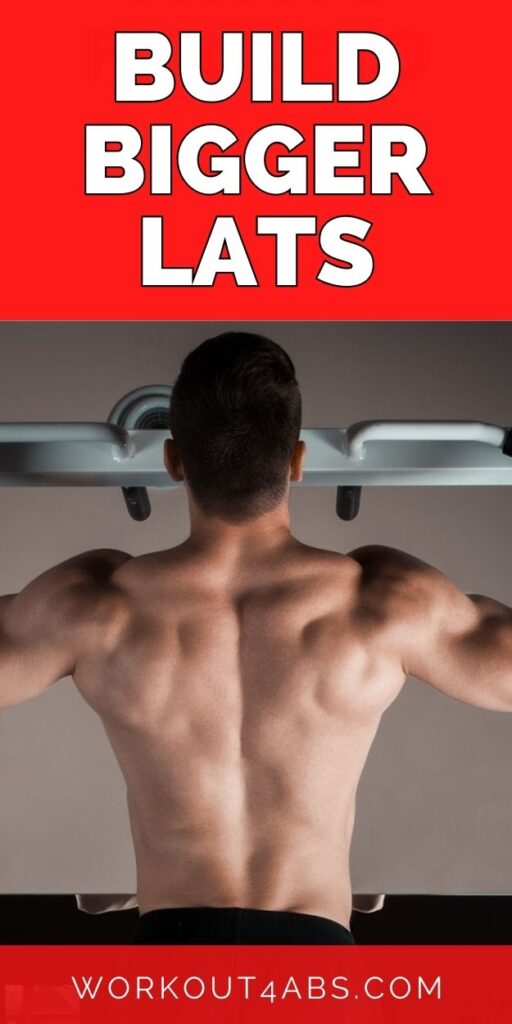Here are the best lat exercises for width. Building bigger, stronger lats not only enhances your physique but also contributes to improved upper body strength and posture. In this article, we’ll explore three of the most effective lat exercises that will help you achieve those coveted wings, elevating your back game to new heights.
Top 3 Lat Exercises for BACK WIDTH
If you enjoyed these tips, please save this pin to your Pinterest Board.

Training Lats in Shortened and Lengthened Ranges to Maximize Muscle Growth
Training the latissimus dorsi muscles (commonly referred to as the lats) in both shortened and lengthened ranges of motion can be an effective strategy to maximize muscle growth and overall development of this muscle group. The lats are a large, fan-shaped muscle group in your upper back that play a significant role in functions like shoulder extension, adduction, and internal rotation. Here’s how targeting both ranges of motion can be beneficial:
1. Shortened Range of Motion (Contraction):
- Exercise Examples: Lat pull-downs, pull-ups, chin-ups, and rows.
- Benefits:
- Maximizes the concentric contraction of the lats, leading to muscle activation and development.
- Emphasizes the pull phase of the movement, which targets the middle and upper portion of the lat muscles.
- Provides the ability to use heavier weights, which can lead to greater muscle tension and mechanical stress.
- Encourages overall lat thickness and width.
2. Lengthened Range of Motion (Stretch):
- Exercise Examples: Straight-arm pull-downs, wide-grip cable rows with a stretch at the end of the movement.
- Benefits:
- Maximizes eccentric contraction (muscle lengthening) of the lats.
- Creates a deep muscle stretch, particularly in the lower portion of the lats, near the insertion point.
- Promotes muscle hypertrophy through increased microtrauma and metabolic stress.
- Helps improve flexibility and mobility in the lats and surrounding muscles.
How to Incorporate Both Ranges:
- Warm-Up: Begin your lat workout with a dynamic warm-up that includes arm circles, shoulder rotations, and shoulder stretches to prepare the lats for action.
- Shortened Range Exercises: Start with compound movements that emphasize contraction. Use exercises like lat pull-downs or pull-ups, targeting the middle and upper lats. Perform these exercises with controlled, full range of motion, and focus on muscle activation.
- Lengthened Range Exercises: After your primary compound lifts, incorporate exercises that emphasize the stretched position of the lats. Straight-arm pull-downs or wide-grip rows with an emphasis on stretching at the bottom are excellent choices. Ensure you maintain good form and control throughout the movements to maximize the stretch.
- Variation: Periodically change your routine and incorporate different exercises and grips to hit the lats from various angles and lengths.
- Progressive Overload: Gradually increase the resistance and intensity of your exercises over time to stimulate muscle growth. This can involve increasing weight, reps, or sets.
- Recovery: Adequate rest, nutrition, and recovery are essential for muscle growth. Ensure you get enough protein, sleep, and rest days between workouts.
By training the lats in both shortened and lengthened ranges, you can stimulate different aspects of muscle growth, leading to improved overall development, strength, and functional capabilities of the latissimus dorsi muscles. This approach contributes to a well-rounded and balanced physique.
If you enjoyed these tips, please save this pin to your Pinterest Board.

Top 3 Exercises for Building Wider Lats
Underhand Barbell Row
The underhand barbell row, also known as the Yates row or reverse grip barbell row, is an effective compound exercise that primarily targets the middle and upper back muscles, including the latissimus dorsi and the lower trapezius. It also engages the biceps, forearms, and rear deltoids. Here’s how to perform the underhand barbell row with proper form:
Equipment Needed:
- A barbell
- Weight plates
- A barbell rack or a secure place to set up the bar
Step-by-Step Instructions:
- Set Up:
- Load the appropriate weight onto a barbell and place it on a squat rack or a secure surface at about waist height.
- Stand facing the barbell with your feet hip-width apart. Your toes should be pointing slightly outward for stability.
- Bend your knees slightly and hinge at your hips to lean forward, maintaining a straight back. Your back should be at about a 45-degree angle to the ground.
- Grip the Bar:
- Reach down and grasp the barbell with an underhand (supinated) grip, meaning your palms should be facing upward, and your hands should be slightly narrower than shoulder-width apart.
- Your hands should be positioned just outside your knees.
- Starting Position:
- Stand up straight, lifting the barbell off the rack, or if you’re using a barbell on the ground, deadlift it up to the starting position.
- Your arms should be fully extended, and the barbell should hang in front of your thighs.
- Execution:
- Exhale and pull the barbell towards your lower abdomen or upper thighs by bending your elbows. Keep your back straight and maintain the 45-degree angle as you pull the bar towards your body.
- Focus on squeezing your shoulder blades together as you lift the bar, engaging your back muscles.
- Continue pulling until the barbell touches your lower abdomen or lightly grazes it.
- Hold the contracted position for a brief pause, feeling the squeeze in your back muscles.
- Lowering the Bar:
- Inhale and slowly lower the barbell back to the starting position while maintaining control.
- Keep your back straight and your core engaged throughout the movement.
- Repetitions:
- Perform the desired number of repetitions (typically 8-12 repetitions per set for muscle-building purposes).
- Completion:
- After completing your set, carefully lower the barbell back onto the rack or the ground, ensuring it’s secure.
Tips:
- Maintain proper posture throughout the exercise, keeping your back straight and chest up.
- Avoid using momentum or swinging the weight. Focus on controlled movements.
- Start with a weight that allows you to perform the exercise with proper form, and gradually increase the weight as you become more comfortable and stronger.
- This exercise can also be performed with an EZ-curl bar for added wrist comfort.
The underhand barbell row is an excellent compound exercise for building strength and muscle mass in the upper back and biceps while also enhancing overall posture and back stability. Always prioritize safety and proper form when performing this exercise.
Medium Grip Weighted Pull Ups
The medium grip weighted pull-up exercise is an advanced variation of the standard pull-up that involves using a weighted belt, a weighted vest, or a weight plate to increase the resistance and intensity of the exercise. It targets the muscles in your back, including the latissimus dorsi, as well as your biceps and forearms. Here’s how to perform the medium grip weighted pull-up:
Equipment Needed:
- A pull-up bar
- A weight belt, weighted vest, or a chain and weight plate
- Weight plates (optional)
Step-by-Step Instructions:
- Set Up:
- Attach the weight belt or weighted vest with the desired amount of weight. Make sure it’s secure and won’t slip or fall during the exercise.
- Stand directly under the pull-up bar with your feet shoulder-width apart and your arms fully extended overhead.
- Reach up and grasp the pull-up bar with a medium grip. A medium grip typically means your hands are spaced slightly wider than shoulder-width apart, but it can vary based on your comfort and preference.
- Ensure your palms are facing away from your body (pronated grip).
- Starting Position:
- Hang from the pull-up bar with your arms fully extended, shoulders relaxed, and your body in a straight line from head to heels.
- Engage your core and maintain a neutral spine throughout the exercise.
- Execution:
- Inhale and start the pull-up by retracting your shoulder blades (pulling them back and down).
- Exhale as you pull your body up towards the bar by bending your elbows and squeezing your shoulder blades together.
- Keep your elbows pointing slightly backward, and avoid swinging or using momentum.
- Continue pulling until your chin is above the bar or at least level with it.
- Hold the Contraction:
- At the top of the pull-up, hold the fully contracted position for a brief pause, squeezing your back muscles.
- Lowering Phase:
- Inhale and slowly lower your body back down to the starting position with control. Keep your body in a straight line as you descend.
- Ensure that your arms are fully extended before starting the next repetition.
- Repetitions:
- Perform the desired number of repetitions. Aim for 3-4 sets of 6-12 reps, depending on your fitness level and training goals.
- Completion:
- After completing your set, release the pull-up bar and carefully remove the weighted belt or vest.
Tips:
- Use proper form and technique throughout the exercise to prevent injury.
- Start with an appropriate amount of weight that allows you to perform the desired number of reps with good form.
- Maintain a controlled tempo during both the lifting and lowering phases.
- Gradually increase the weight as you get stronger over time.
- Incorporate this exercise into your overall back and upper body training routine for balanced muscle development.
The medium grip weighted pull-up is an excellent exercise for building upper body strength and muscle mass, particularly in the back and biceps. It’s essential to prioritize form, progressively increase the resistance, and train within your capabilities to make steady progress in this challenging exercise.
Swimmer Row
Performing a swimmer row with a forward lean can indeed provide a larger stretch in the lats and engage the upper back muscles more intensely. This variation targets the lats, rhomboids, and posterior deltoids effectively. Here’s how to do a swimmer row with a forward lean:
Equipment Needed:
- A cable machine with an adjustable pulley.
- A straight or v-bar attachment.
Step-by-Step Instructions:
- Set Up:
- Attach a straight or v-bar attachment to the low pulley of the cable machine.
- Adjust the weight on the stack to a manageable starting resistance.
- Stand facing the cable machine with your feet shoulder-width apart.
- Hold the handle with both hands in an overhand (pronated) grip, palms facing downward.
- Starting Position:
- Begin by stepping back a few feet from the cable machine, creating tension on the cable.
- Lean forward at your hips while keeping your back straight. The lean should be at about a 45-degree angle to the ground. This forward lean is crucial for maximizing the stretch in your lats.
- Your arms should be fully extended in front of you, and there should be tension on the cable.
- Execution – Pulling Phase:
- Inhale and initiate the movement by retracting your shoulder blades (pulling them back and together).
- Bend your elbows and pull the handle toward your lower abdomen or hips.
- As you pull, focus on squeezing your shoulder blades together and feel the stretch in your lats as they fully engage.
- Hold the Contraction:
- At the end of the pulling phase, when the handle is close to your lower abdomen or hips, hold the fully contracted position for a brief pause.
- Squeeze your shoulder blades together to maximize the engagement of the upper back muscles.
- Return to the Starting Position:
- Exhale and slowly extend your arms forward, returning to the starting position with the forward lean.
- Keep your back straight and maintain control throughout the movement.
- Repetitions:
- Perform the desired number of repetitions. Aim for 3-4 sets of 10-15 reps, depending on your fitness level and training goals.
- Completion:
- After completing your set, carefully release the handle and return it to its starting position on the cable machine.
Tips:
- Ensure you maintain proper form throughout the exercise, especially the forward lean, which is essential for maximizing the lat stretch.
- Engage your core muscles to stabilize your spine during the exercise.
- Adjust the weight on the cable machine as needed to maintain good form and provide a challenging workout.
- Experiment with different handle attachments and grip variations to target various areas of the upper back and lats.
By incorporating the forward lean into your swimmer row, you can enhance the stretch in your lats and create more tension in the upper back muscles, making it a valuable exercise for building strength and promoting good posture.
If you enjoyed these tips, please save this pin to your Pinterest Board.

Home › Aesthetic Body Plan ›Best Lat Exercises for Width